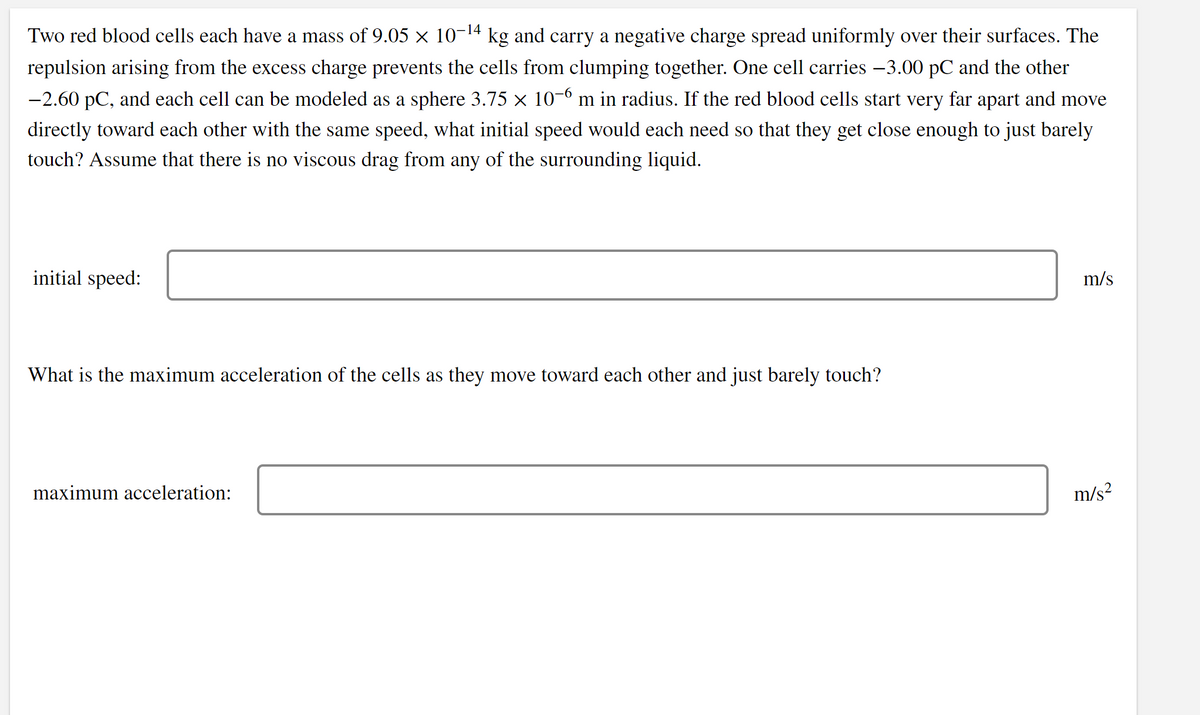Two red blood cells each have a mass of 9.05 × 10-14 kg and carry a negative charge spread uniformly over their surfaces. The repulsion arising from the excess charge prevents the cells from clumping together. One cell carries -3.00 pC and the other -2.60 pC, and each cell can be modeled as a sphere 3.75 × 10-6 m in radius. If the red blood cells start very far apart and move directly toward each other with the same speed, what initial speed would each need so that they get close enough to just barely touch? Assume that there is no viscous drag from any of the surrounding liquid. initial speed: m/s What is the maximum acceleration of the cells as they move toward each other and just barely touch? maximum acceleration: m/s?
Two red blood cells each have a mass of 9.05 × 10-14 kg and carry a negative charge spread uniformly over their surfaces. The repulsion arising from the excess charge prevents the cells from clumping together. One cell carries -3.00 pC and the other -2.60 pC, and each cell can be modeled as a sphere 3.75 × 10-6 m in radius. If the red blood cells start very far apart and move directly toward each other with the same speed, what initial speed would each need so that they get close enough to just barely touch? Assume that there is no viscous drag from any of the surrounding liquid. initial speed: m/s What is the maximum acceleration of the cells as they move toward each other and just barely touch? maximum acceleration: m/s?
Physics for Scientists and Engineers with Modern Physics
10th Edition
ISBN:9781337553292
Author:Raymond A. Serway, John W. Jewett
Publisher:Raymond A. Serway, John W. Jewett
Chapter25: Capacitance And Dielectrics
Section: Chapter Questions
Problem 30P: An infinite line of positive charge lies along the y axis, with charge density = 2.00 C/m. A dipole...
Related questions
Question

Transcribed Image Text:Two red blood cells each have a mass of 9.05 × 10-14 kg and carry a negative charge spread uniformly over their surfaces. The
repulsion arising from the excess charge prevents the cells from clumping together. One cell carries -3.00 pC and the other
-2.60 pC, and each cell can be modeled as a sphere 3.75 × 10-º m in radius. If the red blood cells start very far apart and move
directly toward each other with the same speed, what initial speed would each need so that they get close enough to just barely
touch? Assume that there is no viscous drag from any of the surrounding liquid.
initial speed:
m/s
What is the maximum acceleration of the cells as they move toward each other and just barely touch?
maximum acceleration:
m/s?
Expert Solution
This question has been solved!
Explore an expertly crafted, step-by-step solution for a thorough understanding of key concepts.
This is a popular solution!
Trending now
This is a popular solution!
Step by step
Solved in 3 steps

Knowledge Booster
Learn more about
Need a deep-dive on the concept behind this application? Look no further. Learn more about this topic, physics and related others by exploring similar questions and additional content below.Recommended textbooks for you

Physics for Scientists and Engineers with Modern …
Physics
ISBN:
9781337553292
Author:
Raymond A. Serway, John W. Jewett
Publisher:
Cengage Learning

Physics for Scientists and Engineers
Physics
ISBN:
9781337553278
Author:
Raymond A. Serway, John W. Jewett
Publisher:
Cengage Learning

Physics for Scientists and Engineers: Foundations…
Physics
ISBN:
9781133939146
Author:
Katz, Debora M.
Publisher:
Cengage Learning

Physics for Scientists and Engineers with Modern …
Physics
ISBN:
9781337553292
Author:
Raymond A. Serway, John W. Jewett
Publisher:
Cengage Learning

Physics for Scientists and Engineers
Physics
ISBN:
9781337553278
Author:
Raymond A. Serway, John W. Jewett
Publisher:
Cengage Learning

Physics for Scientists and Engineers: Foundations…
Physics
ISBN:
9781133939146
Author:
Katz, Debora M.
Publisher:
Cengage Learning

Principles of Physics: A Calculus-Based Text
Physics
ISBN:
9781133104261
Author:
Raymond A. Serway, John W. Jewett
Publisher:
Cengage Learning

College Physics
Physics
ISBN:
9781305952300
Author:
Raymond A. Serway, Chris Vuille
Publisher:
Cengage Learning

College Physics
Physics
ISBN:
9781285737027
Author:
Raymond A. Serway, Chris Vuille
Publisher:
Cengage Learning